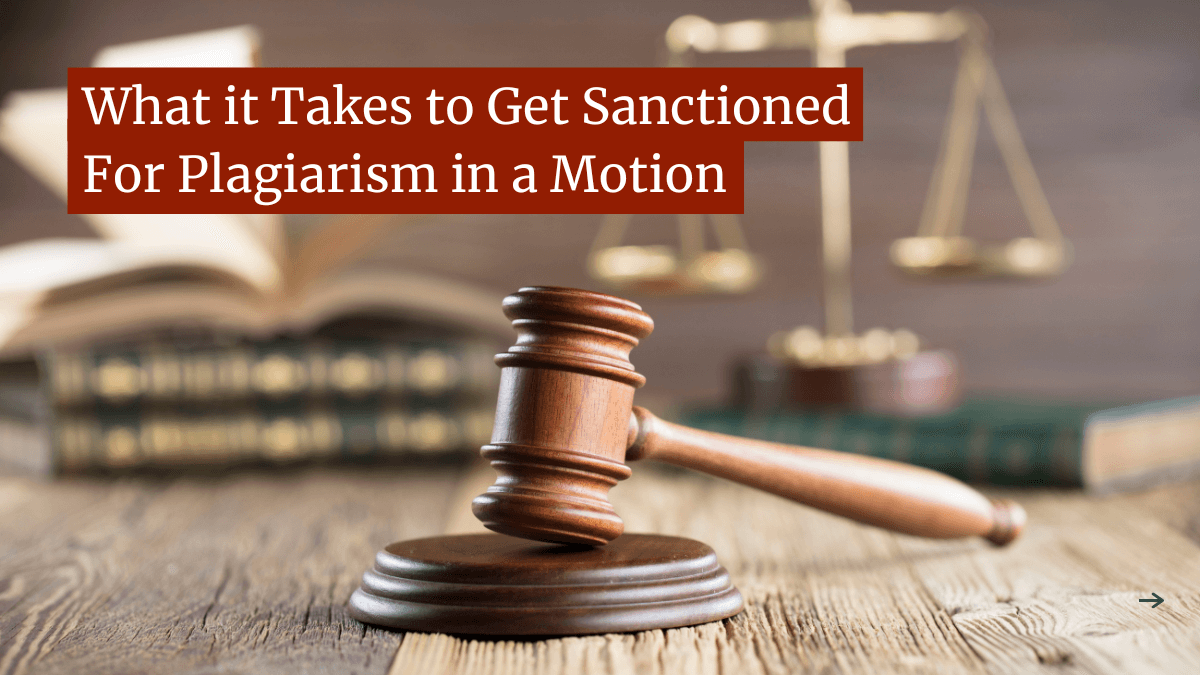Lawyer Sanctioned for Plagiarizing Opposing Counsel

The boundaries of plagiarism vary wildly depending on the type of, the field that it is in, and the expectations of the audience.
For example, a fiction author isn’t held to the same standards as an academic scholar, who isn’t held to the same standards as a songwriter. The rules of plagiarism change based on the norms of the space the work is in.
One of the more complicated areas to look at has always been the legal field.
On one hand, unattributed copying is rampant, widely accepted and even necessary. Much of what lawyers write have only one or two ways that they can correctly be written, thus it’s common to copy the works of others, especially from one’s own firm or their past work.
However, this does not mean that the legal field is a free-for-all when it comes to plagiarism. Citation is often a key component of supporting one’s arguments, and blatantly copying and pasting works of other lawyers is still frowned upon.
Still, it’s rare for plagiarism in the legal field to reach such a level that it results in sanctions for an attorney. However, that’s exactly what happened this week as a judge in Pennsylvania sanctioned a lawyer for “blatant” plagiarism of the opposing council motion.
It’s a bizarre case that demands a closer examination.
Understanding the Plagiarism
According to an article by Eugene Volokh at the The Volokh Conspiracy, the case deals with a flag burning at a protest in Pennsylvania.
In the case, two men, Gene Stilp and Stephen Connolley held a protest on the steps of the Chester County Courthouse where they burned a variety of political flags and other items.
For that, they were issued citations for an unapproved open burning. Those citations were dismissed, but the plaintiffs filed the lawsuit in the hopes of doing more such demonstrations in the future.
Both sides in the case filed motions in limine dealing with witnesses in the case. These are motions filed with the court before jury selection and typically deal with what evidence or testimony will be allowed when the trial begins.
In this case, both sides were seeking to limit the testimony of relevant witnesses in the case. The plaintiffs, Stilp and Connolley, filed a motion to limit the testimony of the police officer that issued the citation. The defense filed a similar motion to limit the testimony of Stilp and Connolley.
However, the defense’s motion turned out to be much too similar. According to the judge, the motions and accompanying briefs were nearly identical, with virtually every paragraph containing “language lifted word-for-word from the plaintiff’s motions.
The lawyer who submitted the plagiarized motion, Christine Munion, did not deny the allegations. The court found that she had violated Pennsylvania’s Rule of Professional Conduct and did a disservice to her client, the Borough of West Chester.
As such, the judge ordered Munion to pay the plaintiff’s lawyers $8,483.55 for the time and expense that was caused by her misconduct. That amount was reduced by $2,256 because, according to the judge, the plagiarism was so flagrant that it could have been brought to the court’s attention without as exhaustive of a review that they performed.
The case itself is ongoing.
While cases like this one are rare, they do happen. In a 2007 article published by Volokh, he highlighted another case where a lawyer was sanctioned for copying 17-pages of a 19-page brief from an article. The lawyer repeated the plagiarism in a second brief, copying most of the article without attribution. In that case, the lawyer was required to complete a course on professional responsibility from an accredited law school.
There have also been cases where judges have reprimanded attorneys but not sanctioned them. One such case was in December 2019 during legal hearings in the Michael Flynn case. In 2011, the Second Circuit Court of Appeals publicly reprimanded lawyer Steven Mundie for a sloppy brief that contained a variety of errors and had so much apparent copying it, “raises the issues of whether Mundie engaged in plagiarism.”
Still, this latest case stands out. Not just for the monetary award, but for the brazenness of it.
Analyzing the Plagiarism
What stands out about this plagiarism is simply how brazen it was. Not only was the copying so extensive that nearly every paragraph contained copied text, but it was of the opposing council’s work at the same stage of the case.
To be clear, the two motions were likely going to have many similarities between them, even if both were written wholly by their respective authors. They were two motions that were being filed at about the same time, seeking the same things, using the same justifications and being filed at the same point in the case.
However, that’s not a justification for failing to do original work and, to make matters worse, it was virtually guaranteed that the two motions would be compared closely because of their similarities going in. There was simply no way that this was not going to be spotted.
To call this an egregious act of plagiarism is an understatement. It is unlike any that I have seen.
That egregiousness is likely what motivated the judge to respond so swiftly and so strongly. Though we don’t know why the lawyer opted to take this approach, it’s clear that being caught was not a great concern. This indicates that they likely felt this was acceptable practice, something that the judge made clear it was not.
To that end, the case is proof that, while the legal profession has different standards when it comes to attribution and citation, it does have standards. Furthermore, should one cross those standards, the consequences can be very costly.
Bottom Line
Typically, plagiarism in legal filing disputes involve works that are outside the court system. It’s rare for such a case to arise from copying other briefs or motions, and even less common for it to arise from copying opposing counsel in the case.
The reason is simple: This simply doesn’t happen that often.
Though the standards of plagiarism may be alien to outsiders of the legal field, there are definitely rules, typically covered by codes of professional conduct that lawyers must abide, and lawyers rarely run afoul of them.
Part of that is because it takes such a large amount of blatant copying to earn a reprimand of any stripe, but it’s also because the vast majority of lawyers take their ethical obligations extremely seriously. That includes not committing plagiarism.
This case is an extreme one. It is notable for being such an incredible outlier. But it serves as a great reminder that the legal field does indeed have standards and practices when it comes to plagiarism, and that the field is not a copy/paste free-for-all.
It’s just fortunately very rare that these issues come to such a head.
Want to Reuse or Republish this Content?
If you want to feature this article in your site, classroom or elsewhere, just let us know! We usually grant permission within 24 hours.
